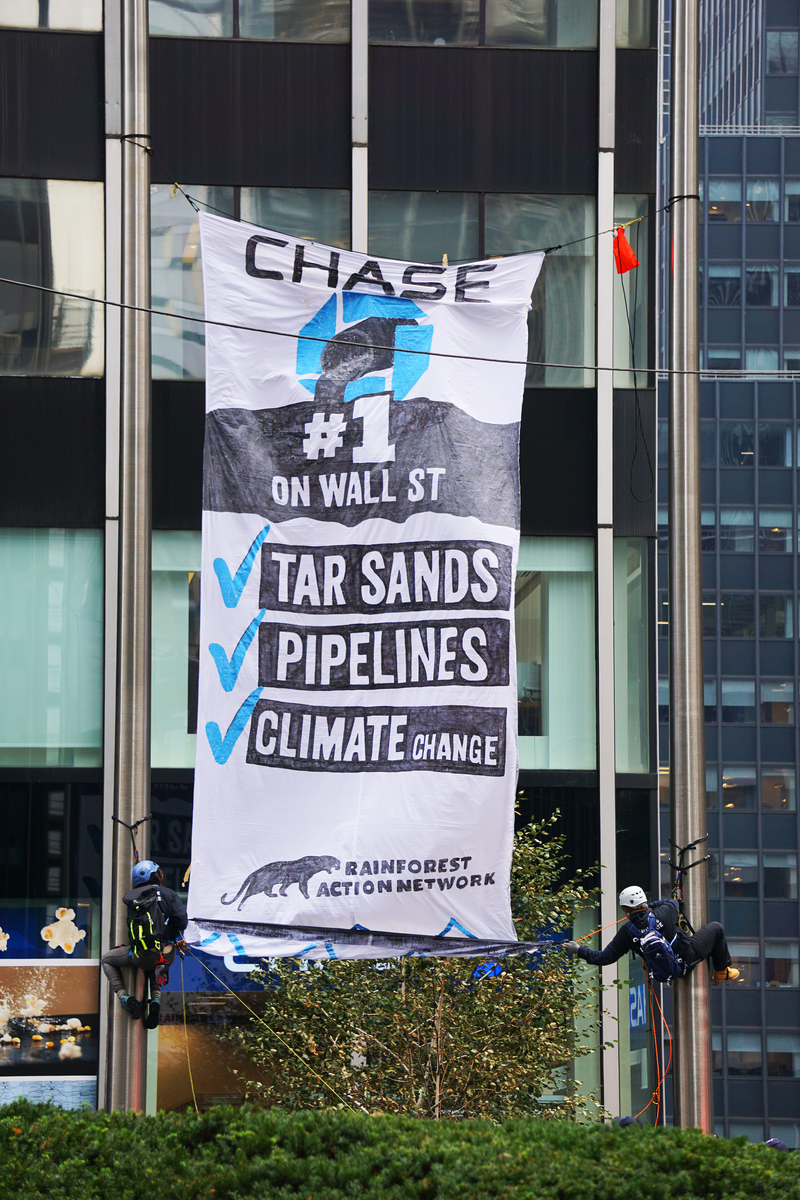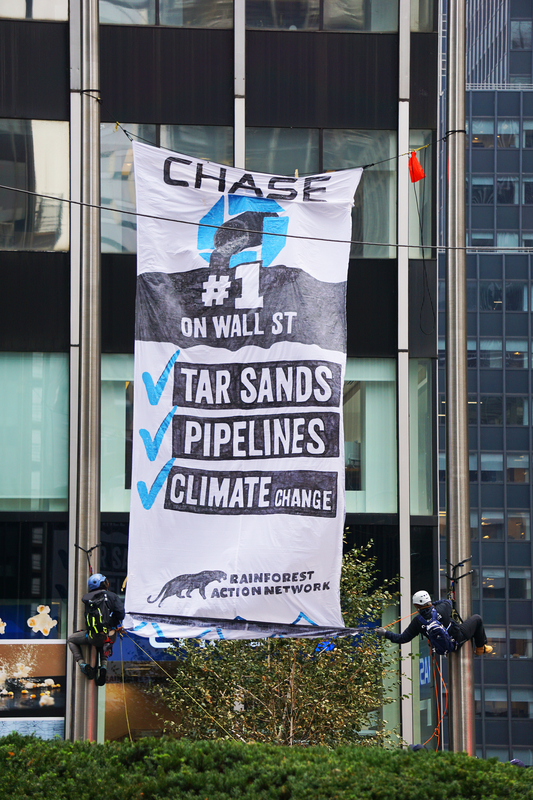This case study was written for our latest bank report card, Banking on Climate Change: Fossil Fuel Finance Report Card 2018.

Photo by Jake Conroy/RAN
JPMorgan Chase stands out in this report’s findings as the top U.S. banker of extreme fossil fuels over the last three years. The bank’s uniquely irresponsible record on extreme fossil fuels has not gone unnoticed.
On May 8, 2017 JPMorgan Chase was the target of a coordinated day of civil disobedience when Indigenous and environmental activists disrupted business at 13 branches across Seattle, Washington.1 The activists protested the bank’s role in financing tar sands pipelines and Indigenous rights abuses; 26 people were arrested. 2
That day of action was a high-water mark in a full year of nonviolent activism resisting JPMorgan Chase’s fossil fuel financing. In April, Indigenous activist Jackie Fielder disrupted the bank’s shareholder meeting, unfurling a banner on stage next to CEO Jamie Dimon calling on JPMorgan Chase to defund tar sands.3 Other activists at the meeting pressed Dimon about JPMorgan Chase’s funding for private prisons.4
On a September visit to Denver, Dimon was welcomed with a public rally at JPMorgan Chase regional headquarters, and Rainforest Action Network staffers hand-delivered a coalition letter calling on JPMorgan Chase to cease funding tar sands.5 The next month, JPMorgan Chase was one of the main targets of the Divest the Globe international days of action, which called on banks to stop financing fossil fuels and Indigenous rights abuses.6 Over 100 JPMorgan Chase bank branches were disrupted as part of the Divest the Globe activities.7
In November, two activists risked arrest to hang a banner in front of JPMorgan Chase headquarters in midtown Manhattan, reading “Chase: #1 on Wall Street — Tar Sands, Pipelines, Climate Change.”8 In December, during Dimon’s keynote conversation at the Wells Fargo Investment Thought Leadership Forum, Indigenous Environmental Network and others attempted to deliver a petition calling on JPMorgan Chase to cut ties with TransCanada. The Water Protectors and allies were roughly expelled by private security.9 On stage, Dimon said, “I don’t know why they’re following me around.”10
Dimon should pay closer attention to what his bank is doing. JPMorgan Chase funds a slew of environmentally destructive tar sands projects. In June, it lent $243 million to the Kinder Morgan Trans Mountain expansion project loan,11 despite a coalition of more than 20 Indigenous and environmental organizations warning the bank about the Indigenous rights and climate impacts of the projects,12 and legal challenges from over a dozen First Nations and the British Columbia government. (Notably, no major U.S. or European bank that was on the Dakota Access Pipeline project loan participated.)
In December, the bank re-upped support for TransCanada, despite the controversy around its Keystone XL pipeline, approving a renewal of a $1.5 billion credit facility that JPMorgan Chase led.13 JPMorgan Chase is a major lender to Enbridge (read the case study on Line 3 here) and Teck, the company behind Frontier, an enormous proposed open-pit tar sands megamine in Alberta. JPMorgan Chase’s fossil fuel financing has impacts far beyond North America. As highlighted in a November Amazon Watch report,14 the bank invests in at least three companies that drill for oil in the Amazon rainforest — in spite of direct opposition from Indigenous Peoples, and with devastating impacts on local communities and the rainforest ecosystem.15 And it continues to take advantage of glaring loopholes in its coal policy to finance companies like Polish utility Energa, which is planning the destructive Ostroleka coal-fired power plant.16
Overall, JPMorgan Chase continues to be uniquely exposed, among its peers, to climate risk through its extreme fossil fuel financing. It is the number one U.S. banker of extreme fossil fuels, with overall exposure increasing by 53 percent from 2016 to 2017.17 In particular, JPMorgan Chase’s financing for tar sands and coal mining have gone through the roof. This report finds that from 2016 to 2017 JPMorgan Chase upped its tar sands financing by 4 times. Its coal mining financing in 2017 is a startling 21 times higher than the previous year — this while the bank purports to have a policy to reduce its credit exposure to coal mining companies!18 JPMorgan Chase is also the top banker of ultra-deepwater oil, and the top Western banker of coal power over the past three years.19
JPMorgan Chase wants to be seen as a responsible actor on climate. In 2017 the bank committed to facilitate $200 billion in clean financing through 2025 and announced that it would source renewable power for 100 percent of its global energy needs by 2020.20 Dimon has publically supported the Paris Agreement.21 Yet at the same time, JPMorgan Chase’s extreme fossil fuel financing is putting a 1.5 degree world further out of reach every month.
1. Lynda V. Mapes, “Climate Activists Shut Down Chase Bank Branches in Seattle; Arrests Made,” Seattle Times, 8 May 2017. ↩
2. Ibid.↩
3. Matt Remle (Lakota),“Coalition Disrupts JPMorgan Chase Shareholders Meeting: Demand They Defund Tar Sands,” Last Real Indians, 16 May 2017.↩
4. Josh Saul, “Jamie Dimon, Head of JPMorgan Chase, Pressed on Private Prisons, Trump Council Seat,” Newsweek, 16 May 2017.↩
5. Alexander C. Kaufman, “JPMorgan Facing A New Environmental Fight Over Tar Sands Funding,” HuffPost, 26 September 2017; “Open Letter From 25 Indigenous and Environmental Groups Calling on JPMorgan Chase to Stop Financing Tar Sands Oil,”various organizations, 25 September 2017. ↩
6. Sara Bernard,“Activists Disrupt Over 100 Bank Branches Across Seattle for Financing Tar Sands Projects,” Seattle Weekly, 23 October 2017.↩
7. Ibid.↩
8. Molly Crane-Newman and Stephen Rex Brown, “Women Climb Flag Poles Near Chase Midtown Building to Protest Bank’s Climate Change Ties,” New York Daily News, 13 November 2017.↩
9. Jade Begay and Ayse Gursoz, “Water Protectors and Environmental Groups Disrupt ‘Wells Fargo Investment Thought Leadership Forum’ Demanding Banks Defund Keystone XL Pipeline,” Indigenous Environmental Network and Rainforest Action Network, 7 December 2017.↩
10. “JPMorgan Chase & Co (JPM) Presents at Wells Fargo Investment Thought Leadership Forum Broker Conference (Transcript),” Seeking Alpha, 7 December 2017.↩
11. Jason Disterhoft, “These Banks Are Financing a Pipeline That Will Let Big Oil Move More Barrels a Day Than Keystone XL or Dakota Access,”AlterNet, 9 July 2017.↩
12. Julien Gignac, “Environmental and Indigenous Groups Demand Banks Avoid Supporting Trans Mountain Expansion,” Toronto Star, 8 June 2017.↩
13. Bloomberg Finance L.P.↩
14. “Stop Investing in Amazon Destruction,”Amazon Watch, 8 November 2017.↩
15. Alexander C. Kaufman,“JPMorgan, BlackRock Tout Climate Bona Fides While Funding Amazon Oil Drilling,” Huffington Post, 10 November 2017.↩
16. Agnieszka Barteczko and Barbara Lewis, “Polish Coal-Burning Companies Find Ways to Win Big Bank Backing,” Reuters, 26 April 2017. ↩
17. See the extreme fossil fuels league table at the beginning of this report. ↩
18. “Environmental and Social Policy Framework,” JPMorgan Chase & Co., accessed February 2018, p. 8.↩
19. All of these statements are sourced from the data researched for this report. See the methodology section and extreme fossil fuels league table for more.↩
20. “JPMorgan Chase to be 100 Percent Reliant on Renewable Energy by 2020; Announces $200 Billion Clean Energy Financing Commitment,” JPMorgan Chase, 28 July 2017.↩
21. Saheli Roy Choudhury,“JPMorgan’s Dimon Says Disagrees with Trump Decision to Quit Climate Deal, But ‘We Have a Responsibility to Engage Our Elected Officials’,” CNBC, 2 June 2017. ↩
